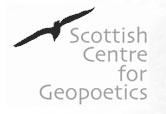Friday 10 July
Geology and geopoetics: Talk and Walk with Alastair and Zoë Fleming
The talk assumed no prior geological knowledge other than background general knowledge. At least half the session was spent outside allowing the rocks of Luing to tell their own story and it inspired some of the geopoeticians among the participants to weave this story into their work.
Alastair and Zoë are amateur geologists who live on Luing. They were previously teachers with a keen interest in geological education. They try to inspire others to share their enthusiasm for the stories of the Earth's history that can be read in the rocks including the fact that Luing was not always an island!
Work in progress
Slate calls to granite
across the moving waters –
a few sea miles, but
a giant step in geology.
Granite calls to slate,
with schist and shale,
and sheer basalt cliffs
falling in between.
Slate calls to granite
where the land has been gouged out,
where the sea licks its wounds.
Granite calls to slate
where red rock bares its breast,
where light-houses were born.
At Camas Tuath on Mull
the quarrymen’s homes,
built of the stone they hewed out,
are roofed with big slates –
seagrey, set with gold,
from Cullipool on Luing.
Granite calls to slate
telling stories of hard graft
and human community.
Slate calls to granite
across the moving waters
granite calls to slate.
Jan Sutch Pickard, Atlantic Islands Festival 2009
The practice of geopoetics: Scottish Centre for Geopoetics contributors.
Jim McCarthy, the author of 8 books including Wild Scotland and An Inhabited Solitude, spoke about his writing of the biographies of explorers and botanists and how it relates to geopoetics. Norman Bissell spoke briefly about how he practises geopoetics in his poetry and in his research into cultural history and biography. a wide-ranging discussion took place on how geopoetics relates to participants' interests and ongoing work.
Jim McCarthy's notes from his talk are available here.
Websites, Geotrail and Slate Sculpture Gardens Showcase.
Rosy Barlow invited those present to send her photographs, artwork, poetry and other writing to put on the geopoetics and Atlantic Island Festival websites. A similar invitation was extended for those with ideas for a Geotrail and Slate Sculpture Gardens around Cullipool to send them in. In this way many of the creative outcomes of the week will be made available for everyone.
Lament and Fingal’s Cave – a showing of two short films by the artist Richard Ashrowan, exploring the geopoetics of two distinct Scottish landscapes, followed by a Q&A discussion between the artist and Norman Bissell then the audience.
Richard Ashrowan is a moving image artist who lives in the Scottish Borders and whose work has been exhibited internationally. In these recent works he explores the Anglo/Scots borderline, and Fingal’s Cave on the uninhabited island of Staffa. In ‘Lament,’ he was invited to consider the geopoetics of the borderline by the Romanian curator Ileana Pintilie. The subsequent work took the form of a single screen moving image installation, artist monograph and still images, created at various locations on the border and first shown in Romania in 2009. In ‘Fingal’s Cave’ he created a multi-screen moving image installation following numerous visits to the remote sea cave on the island of Staffa. The resulting work was shown at the Foksal Gallery in Warsaw in Poland in summer 2008. Images and more information are available at www.ashrowan.com.
A large audience was very appreciative of these beautiful films and of the artist who spoke candidly of all the work that went into their making.
Grand Ceilidh with Seil Ceilidh Band and Children’s Drama performance.
The last big event of the week saw the children attending a series of drama workshops take centre stage with their short drama performance about the Highlands and Islands Clearances directed by Zora King and Marion Sheridan. Particularly effective were the chorus of expressions of feelings by the families as they were evicted from their land and the movement of the emigrant ship which they created by joining hands together.
The Seil Ceilidh Band got everyone on their feet for a succession of dances and some of the artists who had taken part in the Festival like Hugh and Innes MacQueen and Norman Bissell did another turn and were joined by Jim McCarthy singing 'Three Craws' and Bridie Ashrowan singing some lovely songs.





